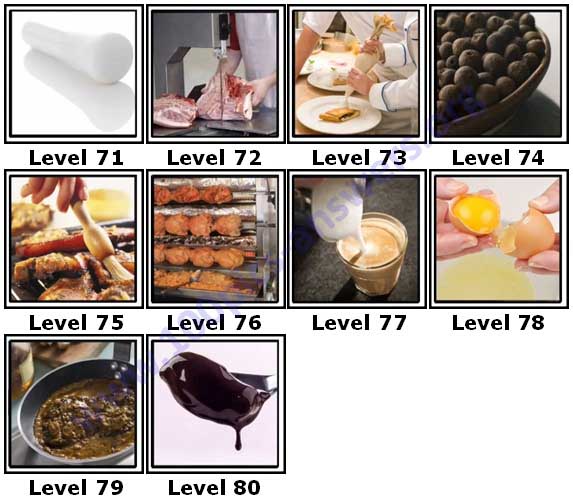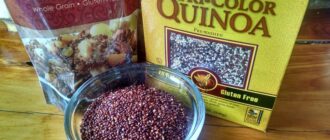
Get Expert Answers to Your Cooking Questions
Welcome to our kitchen, where we provide answers to all your burning cooking questions. Whether you’re a novice in the kitchen or a seasoned chef, we have the expertise to help you improve your culinary skills. Our team of experts is here to guide you through any cooking conundrum you may encounter.
Food is our passion, and we believe that everyone should have the knowledge and skills to create delicious meals at home. That’s why we’re dedicated to answering your questions and providing you with the best tips and tricks to elevate your cooking game.
From basic cooking techniques to advanced recipes, we cover a wide range of topics to cater to all skill levels. Whether you’re wondering how to properly chop an onion or looking for the perfect recipe for a special occasion, our experts are here to assist you every step of the way.
So, don’t hesitate to ask us anything. We’re here to help you become a master in the kitchen and unleash your culinary potential. Let’s dive into the world of cooking together!
How to Make Homemade Pizza Dough
If you love pizza, there’s nothing better than making your own homemade pizza dough. Not only is it fun and rewarding, but it also allows you to customize the dough to your liking. Whether you prefer a thin and crispy crust or a thick and chewy one, making your own pizza dough gives you the freedom to experiment with different flavors and textures.
Here are some tips and tricks to help you make the perfect homemade pizza dough:
- Choose the right flour: The type of flour you use will greatly affect the texture and flavor of your pizza dough. For a classic pizza crust, use bread flour, which has a higher protein content and will result in a chewier crust. If you prefer a lighter and crispier crust, you can use all-purpose flour.
- Use fresh yeast: While you can use dry yeast, fresh yeast will give your dough a better flavor. Dissolve the yeast in warm water with a little sugar to activate it before adding it to the flour.
- Knead the dough: Kneading the dough is an important step in developing gluten, which gives the dough its elasticity. Knead the dough for at least 10 minutes until it becomes smooth and elastic.
- Let the dough rise: After kneading, let the dough rise in a warm place until it has doubled in size. This can take anywhere from 1-2 hours, depending on the temperature of your kitchen.
- Roll out the dough: Once the dough has risen, divide it into smaller portions and roll them out into your desired shape and thickness. Dust the dough with flour to prevent it from sticking to the surface.
- Preheat your oven: Before baking your pizza, make sure to preheat your oven to the highest temperature possible. This will help create a crispy crust.
- Add your favorite toppings: Now comes the fun part – adding your favorite toppings! Whether you prefer a classic Margherita or a loaded meat lover’s pizza, the choice is yours. Just make sure not to overload the pizza with toppings, as this can weigh down the crust.
- Bake and enjoy: Place your pizza on a preheated pizza stone or baking sheet and bake it in the hot oven until the crust is golden brown and the cheese is melted and bubbly. This usually takes around 10-15 minutes, but keep an eye on it to prevent burning.
With these tips and tricks, you can make delicious homemade pizza dough right in your own kitchen. So why not give it a try and impress your friends and family with your culinary skills?
Quick and Easy Dinner Ideas
When it comes to preparing dinner, we understand that you want something quick and easy without compromising on taste. That’s why our expert chefs have come up with a list of delicious and hassle-free recipes that you can try in your own kitchen.
One of our favorite quick dinner ideas is a simple stir-fry. With just a few ingredients and minimal cooking time, you can have a flavorful and healthy meal on the table in no time. Choose your favorite protein, such as chicken, beef, or tofu, and toss it in a hot pan with some vegetables and a sauce of your choice. In just a few minutes, you’ll have a satisfying and nutritious dish that the whole family will love.
If you’re looking for something even quicker, why not try a build-your-own taco bar? This interactive dinner idea allows everyone to customize their own meal according to their preferences. Simply prepare a variety of fillings, such as seasoned ground beef, grilled chicken, or sautéed vegetables, and set out an assortment of toppings and tortillas. Your family and guests can then create their own delicious tacos in a matter of minutes.
For those busy weeknights when you don’t have much time to cook, a sheet pan dinner is the perfect solution. By roasting your protein and vegetables together on a single sheet pan, you can save time on both preparation and clean-up. Simply toss your ingredients with some olive oil and seasonings, spread them out on a baking sheet, and pop them in the oven. In just 30 minutes or less, you’ll have a complete and satisfying meal that requires minimal effort.
When it comes to quick and easy dinner ideas, planning is key. By having a few go-to recipes and keeping your pantry stocked with essential ingredients, you can always whip up a delicious meal in no time. So, next time you’re in need of a quick and easy dinner, remember to check out our expert answers and tips for inspiration in the kitchen.
Baking Tips for Perfectly Fluffy Cakes
If you have questions about baking the perfect cake, our expert is here with the answers! Achieving a fluffy cake with a moist crumb can sometimes be a challenge, but with the right techniques, you can create a masterpiece in your own kitchen.
1. Use the right ingredients: Start with high-quality ingredients, such as fresh eggs, unsalted butter, and pure vanilla extract. Using cake flour instead of all-purpose flour can also help create a lighter texture.
2. Measure accurately: Baking is a science, so it’s important to measure your ingredients accurately. Use measuring cups and spoons, and level off the excess with a straight edge for precise measurements.
3. Cream the butter and sugar: Creaming the butter and sugar together creates air pockets, which will help the cake rise and become fluffy. Beat them together until light and fluffy, usually for about 3-5 minutes.
4. Don’t overmix: Once you add the dry ingredients to the wet ingredients, be careful not to overmix. Overmixing can develop gluten, resulting in a dense and chewy cake. Mix until just combined.
5. Use room temperature ingredients: Make sure your eggs and dairy ingredients are at room temperature before adding them to the batter. This will help them incorporate evenly and create a smoother texture.
6. Don’t open the oven door: While your cake is baking, resist the temptation to open the oven door. Opening the door can cause the temperature to fluctuate, which can result in a sunken cake.
7. Test for doneness: Use a toothpick or cake tester to check if your cake is done. Insert it into the center of the cake, and if it comes out clean or with a few crumbs, your cake is ready.
8. Let it cool properly: Once your cake is baked, allow it to cool in the pan for about 10-15 minutes before transferring it to a wire rack. This will help the cake set and prevent it from breaking apart.
9. Frost with care: When it comes to frosting your cake, make sure it has cooled completely. If the cake is still warm, the frosting can melt and slide off. Use a spatula or an offset spatula for a smooth and even application.
10. Practice makes perfect: Baking is a skill that improves with practice, so don’t be discouraged if your first attempt isn’t perfect. Keep experimenting, learning, and trying new recipes to become a master in the kitchen!
The Secret to Crispy Fried Chicken
When it comes to cooking delicious fried chicken, our expert chefs in the kitchen have all the answers to your questions. Here are some tips to help you achieve that perfect crispy texture:
- Choose the right chicken: Opt for bone-in, skin-on chicken pieces for the best results. The skin adds flavor and helps create that desired crunch.
- Brine the chicken: Soaking the chicken in a brine solution before frying can help tenderize the meat and enhance its flavor. A simple brine of water, salt, and spices works wonders.
- Dry the chicken: After brining, make sure to thoroughly pat the chicken dry with paper towels. This step is crucial to remove excess moisture, which can prevent the chicken from becoming crispy.
- Use the right coating: Dip the chicken pieces in a mixture of flour and seasonings, such as salt, pepper, paprika, and garlic powder. For an extra crispy coating, you can also add cornstarch or breadcrumbs.
- Double-dip for extra crunch: For an even crispier result, dip the chicken in the coating mixture twice. This extra layer of flour and spices helps create a thicker, crunchier crust.
- Fry at the right temperature: Heat your oil to around 350°F (175°C) for frying. Maintaining the right temperature is important for achieving a crispy exterior while ensuring the chicken is thoroughly cooked.
- Don’t overcrowd the pan: When frying the chicken, make sure to leave enough space between the pieces. Overcrowding the pan can cause the temperature to drop, resulting in soggy chicken.
- Drain excess oil: After frying, place the chicken on a wire rack or paper towels to drain any excess oil. This helps preserve the crispiness and prevents the chicken from becoming greasy.
By following these expert tips, you’ll be able to create mouthwatering crispy fried chicken that will impress everyone at your table. So go ahead and get cooking!
Healthy Substitutes for Common Ingredients
When it comes to cooking, it’s not uncommon to come across ingredients that we may not have on hand or that we want to avoid for health reasons. Luckily, there are many healthy substitutes available in the kitchen that can be used to replace common ingredients. Here are some expert tips to help you make healthier choices in your cooking.
1. Butter: Instead of using butter, try using mashed avocado or coconut oil. These alternatives are rich in healthy fats and can add a creamy texture to your dishes.
2. Sugar: Instead of using refined white sugar, opt for natural sweeteners such as honey, maple syrup, or stevia. These alternatives can add sweetness to your food without the negative effects of processed sugar.
3. Flour: Instead of using white flour, try using almond flour, coconut flour, or whole wheat flour. These alternatives are higher in nutrients and fiber, making them a healthier choice for baking.
4. Salt: Instead of using table salt, try using herbs and spices to season your food. Not only will this add flavor, but it will also reduce your sodium intake.
5. Cream: Instead of using heavy cream, try using Greek yogurt or coconut milk. These alternatives can add creaminess to your dishes without the high fat content.
By making these simple substitutions, you can create healthier versions of your favorite dishes without sacrificing taste or texture. So next time you’re in the kitchen, don’t be afraid to get creative and experiment with these healthy alternatives. Your food and your body will thank you!
Mastering the Art of Sushi Making
Are you a sushi lover who dreams of creating your own delicious rolls at home? Our expert chefs are here to answer all your questions and provide you with tips to help you master the art of sushi making in your own kitchen.
One of the most important aspects of sushi making is the quality of the ingredients. Our experts recommend using the freshest fish and seafood you can find. Sushi-grade fish is essential to ensure the safety and taste of your rolls. You can find sushi-grade fish at specialty seafood markets or ask your local fishmonger for recommendations.
Another key tip for sushi making is mastering the rice. The rice is the foundation of any good sushi roll, and it’s important to get the texture and seasoning just right. Our experts suggest using short-grain sushi rice and rinsing it thoroughly before cooking. Once cooked, the rice should be seasoned with a mixture of rice vinegar, sugar, and salt. The rice should be sticky enough to hold together, but not too sticky that it becomes difficult to work with.
When it comes to rolling sushi, practice makes perfect. Our experts recommend starting with simple rolls, such as a classic California roll, and gradually working your way up to more complex rolls. It’s important to use a bamboo sushi mat to help shape and roll the sushi. Wetting your hands with water or vinegar can also prevent the rice from sticking to your hands.
Finally, presentation is key when serving sushi. Our experts suggest using a sharp knife to slice the rolls into bite-sized pieces. Garnish the plate with pickled ginger, wasabi, and soy sauce for dipping. The beauty of sushi lies in its simplicity, so let your creativity shine through in your presentation.
With these expert tips and answers to your sushi making questions, you’ll be well on your way to mastering the art of sushi making in your own kitchen. So gather your ingredients, roll up your sleeves, and get ready to impress your friends and family with your homemade sushi creations.
Essential Tools for Every Home Chef
Whether you’re an expert in the kitchen or just starting out, having the right tools can make all the difference in your cooking. Here are some essential tools that every home chef should have:
- A good set of knives: Invest in a high-quality set of knives that includes a chef’s knife, a paring knife, and a serrated knife. These will be your go-to tools for chopping, slicing, and dicing.
- Cutting board: A sturdy cutting board is a must-have for any cook. Look for one that is made of wood or plastic and is large enough to comfortably chop and prep your ingredients.
- Measuring cups and spoons: Accurate measurements are key to successful cooking. Make sure you have a set of measuring cups and spoons for both liquid and dry ingredients.
- Non-stick frying pan: A good quality non-stick frying pan is essential for cooking eggs, pancakes, and other delicate foods. Look for one with a durable non-stick coating and a comfortable handle.
- Saucepans and pots: Having a variety of saucepans and pots in different sizes will allow you to cook a range of dishes. Look for ones with a heavy bottom for even heat distribution.
- Baking sheets and pans: If you enjoy baking, make sure you have a selection of baking sheets and pans. Look for ones that are non-stick and have a sturdy construction.
- Whisk: A whisk is a versatile tool that can be used for mixing, whipping, and incorporating air into your recipes. Look for one with a comfortable handle and sturdy wires.
- Utensils: Don’t forget about the essential utensils like spatulas, tongs, and a ladle. These will come in handy for flipping, stirring, and serving your food.

With these essential tools in your kitchen, you’ll be well-equipped to tackle any cooking challenge and create delicious meals for yourself and your loved ones.
Tips for Grilling the Perfect Steak
Grilling the perfect steak is a skill that every home cook should master. With the right techniques and a few expert tips, you can achieve delicious results every time you fire up the grill.
First, start with a high-quality cut of steak. Look for well-marbled cuts like ribeye or strip steak, as they will be more tender and flavorful. Before grilling, make sure to let the steak come to room temperature, as this will help it cook more evenly.
Next, season the steak generously with salt and pepper. You can also add your favorite herbs and spices, such as garlic powder or rosemary, to enhance the flavor. For an extra kick, consider marinating the steak for a few hours or overnight in a mixture of olive oil, soy sauce, and Worcestershire sauce.
When it’s time to grill, preheat your grill to high heat. Brush the grates with oil to prevent sticking. Place the steak on the grill and cook for about 4-6 minutes per side for medium-rare, or adjust the cooking time to your desired level of doneness.
While grilling, avoid pressing down on the steak with a spatula, as this will release the juices and result in a drier steak. Instead, let the steak cook undisturbed to develop a nice crust. To ensure even cooking, consider using a meat thermometer to check the internal temperature.
Once the steak is done, remove it from the grill and let it rest for a few minutes. This allows the juices to redistribute, resulting in a juicier and more tender steak. Serve it with your favorite sides, such as grilled vegetables or a baked potato, and enjoy!
How to Properly Season Your Cast Iron Skillet
When it comes to cooking in your kitchen, having the right tools is essential. One kitchen essential that many home cooks swear by is a cast iron skillet. These versatile and durable pans are perfect for cooking a variety of foods, from meats to vegetables. However, to ensure that your cast iron skillet performs at its best, it’s important to properly season it.
Seasoning a cast iron skillet involves coating it with a layer of oil and then heating it to create a non-stick surface. This process not only helps to prevent food from sticking to the pan, but it also helps to protect the skillet from rust and corrosion. To season your cast iron skillet, start by washing it with hot water and a mild dish soap. Then, thoroughly dry the skillet with a towel or by placing it on the stove over low heat.
Once the skillet is dry, use a paper towel to apply a thin layer of oil to the entire surface, including the handle. Vegetable oil or canola oil are commonly used for seasoning cast iron skillets, but you can also use other types of oil, such as flaxseed oil or coconut oil. Be sure to use a small amount of oil, as too much can lead to a sticky or greasy surface.
After applying the oil, use a clean paper towel to remove any excess. Then, place the skillet upside down in a preheated oven at 350 degrees Fahrenheit (175 degrees Celsius). This allows any excess oil to drip off and prevents pooling. Leave the skillet in the oven for about an hour, then turn off the heat and let it cool completely before removing it from the oven.
Repeat this process a few times to build up a good seasoning on your cast iron skillet. Over time, the surface will become smoother and more non-stick. Remember to always avoid using soap on your cast iron skillet after it has been seasoned, as this can strip away the protective layer of oil. Instead, simply wipe it clean with a cloth or brush and rinse with hot water.
Exploring Different Types of Pasta
When it comes to cooking, pasta is a versatile and popular food that can be found in many different shapes and sizes. From spaghetti to penne, there are endless options to choose from. In this article, we will explore some of the most common types of pasta and provide tips on how to cook them to perfection.
One of the most well-known types of pasta is spaghetti. This long, thin noodle is perfect for pairing with a variety of sauces, from marinara to carbonara. To cook spaghetti, bring a large pot of salted water to a boil and add the pasta. Cook for about 8-10 minutes, or until al dente. Remember to stir occasionally to prevent sticking.
Another popular type of pasta is penne. This tube-shaped noodle is often used in dishes like baked ziti or pasta salads. To cook penne, follow the same steps as spaghetti, but cook for a slightly shorter amount of time, around 7-9 minutes. The hollow center of penne allows it to hold onto sauces, making it a great choice for hearty dishes.
If you’re looking for a unique pasta shape, try farfalle, also known as bow tie pasta. This butterfly-shaped noodle is perfect for adding a touch of whimsy to your dishes. To cook farfalle, boil water and add the pasta. Cook for about 10-12 minutes, or until tender. The shape of farfalle allows it to hold onto chunky sauces and ingredients, making it a great choice for pasta salads or creamy dishes.
These are just a few examples of the many types of pasta available. Whether you’re a beginner or an experienced cook, experimenting with different shapes and sizes can add variety to your meals. Remember to follow the cooking instructions on the package and don’t be afraid to get creative with your sauces and toppings. Happy cooking!
Creating Delicious and Nutritious Smoothies
Are you looking for a quick and healthy breakfast or snack option? Look no further than your own kitchen! Smoothies are a fantastic way to pack in nutrients and satisfy your taste buds. Our expert team is here to answer all your questions and provide you with tips for creating delicious and nutritious smoothies.
One of the best things about smoothies is their versatility. You can use a variety of fruits, vegetables, and other ingredients to customize your smoothie to your liking. Whether you prefer a tropical blend with mango and pineapple or a green smoothie packed with spinach and kale, the possibilities are endless.
To make your smoothies even more nutritious, consider adding some protein. This can be in the form of Greek yogurt, nut butter, or a plant-based protein powder. Protein not only helps keep you full and satisfied, but it also aids in muscle recovery and growth.
Another tip for creating a delicious smoothie is to balance the flavors. If your smoothie is too sweet, try adding some lemon or lime juice to brighten it up. On the other hand, if your smoothie is too tart, a small amount of honey or maple syrup can help mellow out the flavors.
Don’t forget to get creative with your toppings! Adding a sprinkle of granola, chia seeds, or shredded coconut can add a nice crunch and extra nutrients to your smoothie. Plus, it makes for a beautiful presentation.
So, what are you waiting for? Get blending and start enjoying the benefits of delicious and nutritious smoothies. And if you have any more questions, don’t hesitate to reach out to our expert team for answers.
The Science Behind Baking Bread
Baking bread is not just a simple task, it is a science. Understanding the science behind baking bread can help you achieve the perfect loaf every time. Whether you are an expert baker or a beginner, knowing the answers to some key questions can elevate your baking skills to a whole new level.
One of the most common questions in bread baking is: why does bread rise? The answer lies in the process of fermentation. When yeast is added to the dough, it feeds on the sugars and produces carbon dioxide gas. This gas gets trapped in the gluten network, causing the dough to rise and create airy pockets in the bread.
Another important question is: why do we knead bread? Kneading is a crucial step in bread making because it helps develop gluten. Gluten is a protein that gives bread its structure and elasticity. By kneading the dough, you are aligning the gluten strands and creating a strong, cohesive network that can trap the gas produced by the yeast.
Temperature is also a critical factor in bread baking. Yeast is most active between 70°F and 90°F (21°C and 32°C). If the temperature is too low, the yeast will be sluggish and the dough will take longer to rise. If the temperature is too high, the yeast can become too active and produce too much carbon dioxide, resulting in a bread that collapses or has large air bubbles.
Lastly, the question of why we let bread dough rest before baking is worth exploring. Resting the dough allows the gluten to relax and the flavors to develop. It also gives the yeast more time to ferment and produce carbon dioxide. This resting period, known as proofing, is crucial for achieving a light and flavorful loaf of bread.
So, the next time you step into your kitchen to bake bread, remember that it’s not just about following a recipe. It’s about understanding the science behind the process and using that knowledge to create the perfect loaf of bread.
Understanding Different Cuts of Meat
When it comes to cooking meat, understanding the different cuts can make a big difference in the outcome of your dish. Each cut of meat has its own unique characteristics and requires different cooking methods to bring out its best flavor and texture. Whether you’re grilling, roasting, or braising, knowing the right cut to use can elevate your cooking to the next level.
One of the most important factors to consider when choosing a cut of meat is its tenderness. Tender cuts, such as filet mignon or ribeye, come from muscles that are not heavily used by the animal, resulting in a more tender and juicy texture. These cuts are best suited for quick cooking methods like grilling or pan-searing.
On the other hand, tougher cuts of meat, such as chuck or brisket, come from muscles that are heavily used by the animal. These cuts have more connective tissue and require longer cooking times to break down the collagen and become tender. Slow cooking methods like braising or stewing are perfect for these cuts, as they allow the meat to become tender and flavorful.
Another factor to consider is the marbling of the meat. Marbling refers to the fat that is dispersed throughout the muscle fibers. More marbling generally means more flavor and tenderness. Cuts like ribeye or New York strip steak are known for their excellent marbling, making them a popular choice for steak lovers.
Finally, it’s important to consider the thickness of the cut. Thicker cuts of meat, like prime rib or pork chops, require longer cooking times to ensure that the center is cooked to the desired doneness without overcooking the outer layers. Thinner cuts, like flank steak or pork tenderloin, cook more quickly and are ideal for dishes that require a shorter cooking time.
Understanding the different cuts of meat can help you choose the right cut for your recipe and ensure that your dish turns out delicious every time. Whether you’re grilling a steak, roasting a whole chicken, or braising a pot roast, knowing the characteristics of each cut will give you the confidence to create amazing meals in your kitchen.
Tips for Cooking with Fresh Herbs
When it comes to adding flavor to your dishes, fresh herbs can be a game-changer. Whether you’re a seasoned chef or just starting out in the kitchen, incorporating fresh herbs into your cooking can take your dishes to the next level. Here are some expert tips to help you make the most of your fresh herbs:
- Choose the right herbs: Different herbs have different flavors and pair well with different types of dishes. Experiment with a variety of herbs like basil, cilantro, rosemary, thyme, and mint to find the ones that complement your favorite recipes.
- Store them properly: Fresh herbs are delicate and can wilt quickly if not stored correctly. To keep your herbs fresh, trim the stems and place them in a glass of water, covering the leaves with a plastic bag. Store them in the refrigerator and change the water every few days.
- Use them at the right time: While some herbs like basil and cilantro are best added at the end of cooking to preserve their flavors, others like rosemary and thyme can be added earlier to infuse their flavors into the dish. Pay attention to the cooking time and add the herbs accordingly.
- Experiment with combinations: Don’t be afraid to mix and match different herbs to create unique flavor profiles. Combining herbs like basil and mint can add a refreshing twist to salads or cocktails, while rosemary and thyme can enhance the flavors of roasted meats.
- Chop them properly: To release the flavors of the herbs, it’s important to chop them correctly. Use a sharp knife and make sure to remove any tough stems. For a stronger flavor, finely chop the herbs, and for a milder flavor, chop them coarsely.
By following these tips, you can elevate your cooking with the vibrant flavors of fresh herbs. So, next time you’re in the kitchen, don’t forget to reach for those fragrant leaves and add a touch of freshness to your dishes.
How to Make the Best Chocolate Chip Cookies
When it comes to cooking, everyone has questions, and we have the answers! If you’re looking to perfect your chocolate chip cookie recipe, you’ve come to the right place. Our expert tips will help you create the best batch of cookies you’ve ever tasted.
First, it’s important to use high-quality ingredients. Opt for real butter instead of margarine, and choose a good quality chocolate for the chips. These simple swaps can make a big difference in the final result.
Next, consider the texture of your cookies. If you prefer a chewy cookie, use more brown sugar in your recipe. For a crispier cookie, use more granulated sugar. You can also experiment with different ratios of white and brown sugar to achieve your desired texture.
Another tip is to chill your cookie dough before baking. This allows the flavors to meld together and prevents the cookies from spreading too much in the oven. Simply cover the dough and refrigerate for at least an hour, or even overnight, for the best results.
Lastly, pay attention to your baking time and temperature. Overbaking can result in dry and crumbly cookies, while underbaking can leave them too soft and doughy. Keep a close eye on your cookies and remove them from the oven just as the edges start to turn golden brown.
So, whether you’re a novice in the kitchen or an experienced baker, these tips will help you create the best chocolate chip cookies. Get ready to impress your friends and family with your newfound baking skills!
Quick and Healthy Breakfast Ideas
Are you tired of the same old breakfast routine? Looking for some quick and healthy options to start your day? Our cooking expert is here to answer your questions and provide you with some delicious ideas to kickstart your morning.
When it comes to breakfast, it’s important to fuel your body with nutritious food that will keep you energized throughout the day. One tip is to incorporate protein into your breakfast to help keep you full and satisfied. Try adding some scrambled eggs or Greek yogurt to your meal.
If you’re short on time in the morning, prepping your breakfast the night before can be a game-changer. Overnight oats are a popular choice and can be customized with your favorite toppings such as berries, nuts, or honey. Another option is to make a batch of homemade granola bars that you can grab on the go.
For those who prefer a savory breakfast, avocado toast is a quick and easy option. Simply mash an avocado onto whole grain toast and top it off with a sprinkle of salt and pepper. You can also add some sliced tomatoes or a poached egg for extra flavor.
Don’t forget about the power





